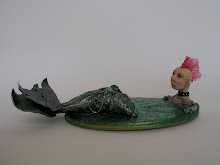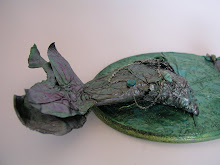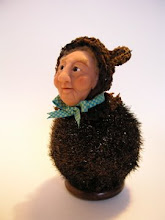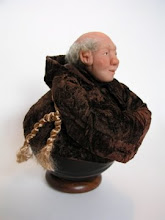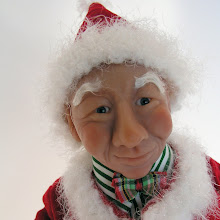I've never been much of a joiner. I'm not antisocial; I just prefer the solitary heaven of my studio. But for the last four years or so, I've had the great pleasure of finding a wealth of like-minded folks with whom to share a variety of forms of creative madness. My Story Circle Network chapter, Wordweavers; a writing/critique group we just call the BGs; and, most recently, an on-line group called Artdollz have enriched my life, creative and otherwise, in so many ways. All of them serve to lure, push, cajole, and drag me out of the various boxes I find myself in.
Some of the things I have most enjoyed about Artdollz in the short time I've been a member are the challenges, round robins, and doll swaps members may participate in throughout the year. These are usually a set of loose parameters and a deadline intended to stimulate us to do something we might not do otherwise and to try out new materials and techniques. I just finished and shipped off my first swap doll, and now I'm eagerly waiting to see what cool doll I'll get back in return, and from whom.
This swap had several requirements. The doll had to be flat-backed so that it could hang on a wall, but it should be three dimensional. It should depict something mythological, either classical, fictional, or from the artist's own mythology. And it had to incorporate a material called Tyvek, which does interesting things when it's heated. You're all probably familiar with Tyvek, even though you may not know it; it's that papery waterproof material that some Fed Ex envelopes and light jackets are made from. I didn't know the material by name, but it had always intrigued me. After a few hints from Artdollz members, I was off. I thought about several possible subjects for this challenge, but I kept coming back to a punk doll I had made at least a decade ago, but was never satisfied with. I played with the Tyvek by ironing it inside a folded Teflon sheet, and as the material morphed, I started to see what I wanted to do with it.
First I disassembled the old doll and trimmed the head off just at the shoulders. I'm posting the technical processes and materials below for anyone who's interested. For those of you who are not, I'll just cut to the chase here. What popped into my mind was a punk merman, with a black/gray color scheme, a neon mohawk "fin" on his head, a ripped shirt, and a tail with chains. I decided to call him Liverpool Merman as a tribute to the British punk scene and because of the play on the word pool where he might hang out. I'm now totally in love with Tyvek and have a head full of ideas about what I'd like to do with it next. I also really liked the way the merman turned out. I hope that whoever gets him in the swap will feel the same.
PROCESS/MATERIALS
The punk bust is Super Sculpey, if I remember correctly. The eyes are painted pin heads, the nose pierce is a cut-off steel dressmaker's pin, and all the other piercings are wire twists inserted into the polymer before curing. The collar is black Fimo with pin heads (like the nose stud), built onto the neck before curing. I secured the bust through the wooden base with Crafter's Choice glue and a regular metal screw through a drilled hole.
The "water" is Tyvek lightly ironed inside a Teflon sheet so the wrinkles are minimal and then painted with Lumiere. I also sprinkled it while wet with some Pearl-X powder and crystal glitter and then muddled everything a bit to simulate water surface and sunlight. I used Sculpey matte glaze as a seal after the paint was dry.
The tail is Creative Paperclay over wire mesh to hold the shape. When the paperclay was dry, I glued more severely distressed, puffy Tyvek around the tail and fin and painted it with Lumiere. The hip wrap is a separate piece of Tyvek, again glued to the form and painted, and "closed" with purchased dyed shells and silver chain. I used more of the same shells hot-glued to the wooden base to brace the doll's neck and ground the upper portion of the piece and to provide some texture to balance the highly-textured tail portion. I added just a bit of drybrushed Lumiere paint (in a couple of coordinating colors) to integrate the colors of the dyed shells into the overall design. In order to assemble the piece, I allowed for the wire mesh to extend a bit beyond the paperclay part of the tail that would show and slipped that through a slit in the "water," with everything (tail and water) securely held in place with Crafter's Choice glue.
The mohawk fin is also Tyvek, subjected to very high heat and severely distressed. It's translucent and very porous, like fan coral. I glued the fin to the doll's head and then used gel medium with fiber to form the doll's original "hair" mohawk into coral-like branches or strands that I gelled to the fin. When the gel medium was dry, I painted the fin with very diluted Lumiere, almost like an ink wash, and added some wash to the tail fin as well, to carry the pink color throughout the doll.
This guy can hang on the wall by his punk safety pin hanger, but he prefers to sit on a table or shelf.
Thursday, May 15, 2008
Liverpool Merman
Labels:
Creative Paperclay,
dolls,
Liverpool,
Lumiere paints,
mermaid,
merman,
mohawk,
punk,
sculpture,
Tyvek
Monday, May 12, 2008
Doris and Kandinsky
I wrote this piece nearly five years ago for my mother, and it was originally published in the Story Circle Network newsletter. When I gave it to her, she loved it, but she couldn't resist reminding me that I "forgot about the matching hairbands." Some of you have seen it, but it's still one of my favorites. Today is my beautiful mother's 86th birthday, so Mom, this one's for you . . . again.
DORIS AND KANDINSKY
The way I see it, he might have just been mental, or a Roaring Twenties avant garde blowhard, merely claiming to hear sounds when he saw colors. But the Russian painter Wassily Kandinsky swore by his synesthesia. For him, yellow was the high brass, all trumpets and fanfares. Crimson red, a drum-roll, or the horns. Violet, a bagpipe. Orange, the middle bells of the church or a strong contralto voice. Every canvas also a choir.
Kandinsky's colors were always singing, and I half believe him today, walking down this island street with its brightly painted row houses in full chorus. They're a tropical marimba of heliotrope, orchid, pomegranate, mustard and mango, sage green with magenta trim, clotted cream and colonial blue and spicy shrimp creole all cobbled together in an eye-boggling cascade of the happiest dwellings I've ever seen. The ones facing the ocean are upscale, of course--pristine and promiscuous at the same time, parading themselves before the monochrome sea and the cloud-pocked sky with French doll house façades, fancy-work doors, and second-story gardens in flagrant bloom. Farther into the city, the houses are dingy--patched and peeling; it's a sadder song there, about life in a different key.
I think of my mother, Doris, born in 1922, the year Kandinsky began painting his Bauhaus series, Kleine Welte (Small World). She would be a beautiful woman, with dark hair and blue-gray eyes and luminous skin, but her tall frame and big feet embarrassed even a family of farmers. Her teen-age years coincided with the Great Depression, and in her high school pictures, she's wearing homemade dresses and too-small shoes. In that faded time, she hoarded her gifts--a voice always hungry for music, and a color memory so accurate, she could match something precisely months or even years later, after having seen it only once.
In a fairer world, she could have turned either one of her talents into a million bucks. Instead, she spent them on me. An older friend made her learn to sew when I was a baby, and from that moment on, I was her anti-Depression billboard. We were always looking for, in her words, "something a little more unusual."
Instead of the gray suede penny loafers I wanted--just like everybody else's--she bought me robin's egg blue, spool-heeled leather shoes, with cutwork and grosgrain ribbon ties. They matched the linen A-line Easter dress she designed when I was a sophomore in high school. Hand crafted, not homemade. My junior year, it was an avocado silk blouse with black polka dots, a black raw silk jumper, and matching hat, a Mr. John Jr. straw roller. To the football games, I wore hand-pleated plaid wool skirts with perfectly coordinated sweaters and high heels. I had the same custom-made dress as all the other girls in my vocal group, but my edge was underwear, royal blue, dyed to match. I was my mother's Barbie, her ikebana, her work of art.
Today, if you walked out of your house in this rich port town, my mother could pick you out a pair of pumps the exact shade of the flowers spilling off your balcony. Later, when you looked out over the railing in the early evening light to call down to your friend in the street below, wearing your new shoes and leaning way over to the side so the bougainvillea wouldn't scratch you, with your forearms resting on the balcony rail and all your weight on your right leg, your left leg cocked a little flirtatiously behind, and the fuschia shoe half off and dangling from your left foot like a decorative counterweight--at that moment, it would appear to any passerby that you and the shoe and the flowers had been painted by the same hand, by Kandinsky, the man who could hear purple, or by my mother, who could match it tone for tone.
DORIS AND KANDINSKY
The way I see it, he might have just been mental, or a Roaring Twenties avant garde blowhard, merely claiming to hear sounds when he saw colors. But the Russian painter Wassily Kandinsky swore by his synesthesia. For him, yellow was the high brass, all trumpets and fanfares. Crimson red, a drum-roll, or the horns. Violet, a bagpipe. Orange, the middle bells of the church or a strong contralto voice. Every canvas also a choir.
Kandinsky's colors were always singing, and I half believe him today, walking down this island street with its brightly painted row houses in full chorus. They're a tropical marimba of heliotrope, orchid, pomegranate, mustard and mango, sage green with magenta trim, clotted cream and colonial blue and spicy shrimp creole all cobbled together in an eye-boggling cascade of the happiest dwellings I've ever seen. The ones facing the ocean are upscale, of course--pristine and promiscuous at the same time, parading themselves before the monochrome sea and the cloud-pocked sky with French doll house façades, fancy-work doors, and second-story gardens in flagrant bloom. Farther into the city, the houses are dingy--patched and peeling; it's a sadder song there, about life in a different key.
I think of my mother, Doris, born in 1922, the year Kandinsky began painting his Bauhaus series, Kleine Welte (Small World). She would be a beautiful woman, with dark hair and blue-gray eyes and luminous skin, but her tall frame and big feet embarrassed even a family of farmers. Her teen-age years coincided with the Great Depression, and in her high school pictures, she's wearing homemade dresses and too-small shoes. In that faded time, she hoarded her gifts--a voice always hungry for music, and a color memory so accurate, she could match something precisely months or even years later, after having seen it only once.
In a fairer world, she could have turned either one of her talents into a million bucks. Instead, she spent them on me. An older friend made her learn to sew when I was a baby, and from that moment on, I was her anti-Depression billboard. We were always looking for, in her words, "something a little more unusual."
Instead of the gray suede penny loafers I wanted--just like everybody else's--she bought me robin's egg blue, spool-heeled leather shoes, with cutwork and grosgrain ribbon ties. They matched the linen A-line Easter dress she designed when I was a sophomore in high school. Hand crafted, not homemade. My junior year, it was an avocado silk blouse with black polka dots, a black raw silk jumper, and matching hat, a Mr. John Jr. straw roller. To the football games, I wore hand-pleated plaid wool skirts with perfectly coordinated sweaters and high heels. I had the same custom-made dress as all the other girls in my vocal group, but my edge was underwear, royal blue, dyed to match. I was my mother's Barbie, her ikebana, her work of art.
Today, if you walked out of your house in this rich port town, my mother could pick you out a pair of pumps the exact shade of the flowers spilling off your balcony. Later, when you looked out over the railing in the early evening light to call down to your friend in the street below, wearing your new shoes and leaning way over to the side so the bougainvillea wouldn't scratch you, with your forearms resting on the balcony rail and all your weight on your right leg, your left leg cocked a little flirtatiously behind, and the fuschia shoe half off and dangling from your left foot like a decorative counterweight--at that moment, it would appear to any passerby that you and the shoe and the flowers had been painted by the same hand, by Kandinsky, the man who could hear purple, or by my mother, who could match it tone for tone.
Labels:
color,
mothers,
Puerto Rico,
synesthesia,
Wassily Kandinsky
Thursday, May 8, 2008
That Old Thing?
The question isn’t why I hang on to one old thing. It’s why I have trouble throwing anything away. I’m working on that, feeling more and more burdened by the crush of things in my life, but the problem is that the tendency is partly learned and partly the function of being a maker. At the risk of appearing to argue for what would seem to be a clear-cut case of hoarding behavior, it’s not quite as dysfunctional as it looks, first-glance.
The learned part is a legacy from my Depression-era mom who grew up hearing the grandmother who raised her say things like, “Don't throw away that old coat. We may need to cut it down for the kids, come winter.” It was a waste-not, want-not mentality that is beginning to find itself reinvented in our uncertain economic times. With a shed full of hand-made and thrift store garments, a studio room crammed top to bottom with fabric and trims, and racks of vintage (read: “old”) clothes in my house, all remnants of my decade as a theatre costumer, I’m well-placed to ride the wave of recycle and re-use nostalgia currently manifesting in a lifestyle/fashion movement called Steampunk. At least that’s my story today. And if global warming, in its unpredictable mix of hot and cold, throws us a particularly nasty winter curveball, I can take care of the kids’ coat crisis all by myself. I think I’ll hang on to that stuff for at least one more season.
The maker conundrum is even more insidious. Makers are, by necessity, pack rats, because in order to make something new, we have to have stuff, supplies, materials, inspirational stashes of fabric and paper and glitter and buttons and zippers and trim and brass tubing and wire and . . . well, you get the idea. There’s nothing worse than sitting straight up in bed in the middle of the night with a crystal clear vision of the solution to that design problem that’s been vexing you and realizing that you can’t do a blasted thing about it because the craft and fabric stores don’t open until 10 a.m. Writing it down or drawing it in your journal won’t help. You need to do while it’s fresh on your mind, and you can’t do without the right stuff. And what if the brilliant solution you saw in your dream depends on something exactly like those plastic florist tubes (both the green pointy ones and the snub-nose clear ones) that you’ve been saving in the kitchen drawer for the last seven years? Problem solved. Smart me. I’ve got a life-time supply that didn’t cost me a penny, and I can get right to work.
The reason it’s so hard to address “maker syndrome” is something called random reinforcement. If you run a laboratory rat through a maze toward a dispenser button and, every once in a while in a totally random sequence, reward it with food pellets when it presses the button, it will just keep running the maze and pressing the button regardless of whether it gets any more food or not. Because sometime in the past the behavior worked and, bon appétit, there was lunch. Now I’m not saying I’m a lab rat (despite a few other other distinctly rodent-like qualities) but let’s face it. If I solved a problem using stuff I’d saved for just such an occasion, doesn’t that encourage me to keep identifying said useful-looking stuff and socking it away? That’s both the beauty and the horror of random reinforcement. What are the odds there’s going to be large-scale de-accessioning of interesting and/or useful-looking stuff at my house when just this week I managed to use a wasp nest, a rock, some honeycomb-cut packing paper, and a thrift store candlestick in one of my dolls? You just never know when you might need, metaphorically speaking, to cut that old coat down for the kiddies.
I haven’t taken to disassembling non-working appliances to strip them for parts and wire yet, and I’ve actually made a healthy number of Goodwill and Salvation Army donations over the years, but it’s the tip of the iceberg, folks. Plus, I already regret letting go of a few of those items. Anybody up for a Savers run? Thursday’s the day they mark down a brand new batch of really cool stuff!
The learned part is a legacy from my Depression-era mom who grew up hearing the grandmother who raised her say things like, “Don't throw away that old coat. We may need to cut it down for the kids, come winter.” It was a waste-not, want-not mentality that is beginning to find itself reinvented in our uncertain economic times. With a shed full of hand-made and thrift store garments, a studio room crammed top to bottom with fabric and trims, and racks of vintage (read: “old”) clothes in my house, all remnants of my decade as a theatre costumer, I’m well-placed to ride the wave of recycle and re-use nostalgia currently manifesting in a lifestyle/fashion movement called Steampunk. At least that’s my story today. And if global warming, in its unpredictable mix of hot and cold, throws us a particularly nasty winter curveball, I can take care of the kids’ coat crisis all by myself. I think I’ll hang on to that stuff for at least one more season.
The maker conundrum is even more insidious. Makers are, by necessity, pack rats, because in order to make something new, we have to have stuff, supplies, materials, inspirational stashes of fabric and paper and glitter and buttons and zippers and trim and brass tubing and wire and . . . well, you get the idea. There’s nothing worse than sitting straight up in bed in the middle of the night with a crystal clear vision of the solution to that design problem that’s been vexing you and realizing that you can’t do a blasted thing about it because the craft and fabric stores don’t open until 10 a.m. Writing it down or drawing it in your journal won’t help. You need to do while it’s fresh on your mind, and you can’t do without the right stuff. And what if the brilliant solution you saw in your dream depends on something exactly like those plastic florist tubes (both the green pointy ones and the snub-nose clear ones) that you’ve been saving in the kitchen drawer for the last seven years? Problem solved. Smart me. I’ve got a life-time supply that didn’t cost me a penny, and I can get right to work.
The reason it’s so hard to address “maker syndrome” is something called random reinforcement. If you run a laboratory rat through a maze toward a dispenser button and, every once in a while in a totally random sequence, reward it with food pellets when it presses the button, it will just keep running the maze and pressing the button regardless of whether it gets any more food or not. Because sometime in the past the behavior worked and, bon appétit, there was lunch. Now I’m not saying I’m a lab rat (despite a few other other distinctly rodent-like qualities) but let’s face it. If I solved a problem using stuff I’d saved for just such an occasion, doesn’t that encourage me to keep identifying said useful-looking stuff and socking it away? That’s both the beauty and the horror of random reinforcement. What are the odds there’s going to be large-scale de-accessioning of interesting and/or useful-looking stuff at my house when just this week I managed to use a wasp nest, a rock, some honeycomb-cut packing paper, and a thrift store candlestick in one of my dolls? You just never know when you might need, metaphorically speaking, to cut that old coat down for the kiddies.
I haven’t taken to disassembling non-working appliances to strip them for parts and wire yet, and I’ve actually made a healthy number of Goodwill and Salvation Army donations over the years, but it’s the tip of the iceberg, folks. Plus, I already regret letting go of a few of those items. Anybody up for a Savers run? Thursday’s the day they mark down a brand new batch of really cool stuff!
Thursday, May 1, 2008
Brown
Ask a dozen people at random what their favorite color is and the odds are excellent that not a single one of them will choose brown. Ask those same people about dessert, and chocolate--rich, beloved, brown chocolate--stands a good chance of topping the list. Go figure.
What is it about unassuming brown that makes it so easy to overlook? Perhaps it's simply ubiquity. Just glancing up from my keyboard I see countless shades and hues of brown: wood furniture, shelves, and light fixtures. The chair I'm sitting in is upholstered in brown. There are brown cardboard cartons on the floor, and the drapes are striped in brown. Outside, the soil is brown, as are the tree trunks and plant stems and rocks and buildings. We brown our steaks and our cakes and our bread. We drink brown tea and coffee, although we call it black. In fact, our world is permeated with browns, so much so that perhaps we simply take them for granted.
I'm such a color freak that I can hardly ever choose a favorite, but I love the richness of mahogany, the variegated browns of baskets, the hatched brown and gray bark of the white crepe myrtle trees outside in the yard, oak's golden glow, the elegant calligraphy of dark brown trunks against masses of bright leaves in season or drawn starkly against the sky in winter, my husband's strong beautiful hands, my daughter's eyes. Brown is logs burning in the fireplace, home, food, dogs, horses, the earth.
This week I finished two dolls, both for friends and both brown. The friar's brown robe is a traditional statement of modesty and humility and a vow of poverty and service. Teddy's brown fur is a promise of comfort and unconditional, completely non-judgmental love. Not too shabby for a color that's nobody's first choice. Maybe I'll look back on this as the beginning of my Brown Period. And maybe next time somebody asks you what your favorite color is, you'll pause for a second, just to look around and silently acknowledge burnt umber, sienna, caramel, cinnamon, teak, chestnut, mink, bay, sorrel, taupe, terracotta, and the rest of brown's gorgeous children, before making the safe choice . . . blue.
What is it about unassuming brown that makes it so easy to overlook? Perhaps it's simply ubiquity. Just glancing up from my keyboard I see countless shades and hues of brown: wood furniture, shelves, and light fixtures. The chair I'm sitting in is upholstered in brown. There are brown cardboard cartons on the floor, and the drapes are striped in brown. Outside, the soil is brown, as are the tree trunks and plant stems and rocks and buildings. We brown our steaks and our cakes and our bread. We drink brown tea and coffee, although we call it black. In fact, our world is permeated with browns, so much so that perhaps we simply take them for granted.
I'm such a color freak that I can hardly ever choose a favorite, but I love the richness of mahogany, the variegated browns of baskets, the hatched brown and gray bark of the white crepe myrtle trees outside in the yard, oak's golden glow, the elegant calligraphy of dark brown trunks against masses of bright leaves in season or drawn starkly against the sky in winter, my husband's strong beautiful hands, my daughter's eyes. Brown is logs burning in the fireplace, home, food, dogs, horses, the earth.
This week I finished two dolls, both for friends and both brown. The friar's brown robe is a traditional statement of modesty and humility and a vow of poverty and service. Teddy's brown fur is a promise of comfort and unconditional, completely non-judgmental love. Not too shabby for a color that's nobody's first choice. Maybe I'll look back on this as the beginning of my Brown Period. And maybe next time somebody asks you what your favorite color is, you'll pause for a second, just to look around and silently acknowledge burnt umber, sienna, caramel, cinnamon, teak, chestnut, mink, bay, sorrel, taupe, terracotta, and the rest of brown's gorgeous children, before making the safe choice . . . blue.
Subscribe to:
Comments (Atom)



